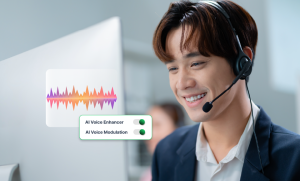In a global contact center, clarity often matters more than language itself. When customers call for support, they expect immediate understanding—not repeated explanations or strained conversations caused by accent differences. Yet accent-related miscommunication remains one of the most persistent challenges in customer service operations worldwide.
For contact centers managing multilingual teams across India, the Philippines, Latin America, and beyond, accent variance can create friction that affects resolution times, customer satisfaction scores, and agent confidence. The result? Escalations increase, call durations extend, and both customers and agents leave interactions feeling frustrated. This is where AI accent translation contact center technology steps in—not to erase identity, but to enhance mutual understanding.
What Is AI Accent Translation and How Does It Work?
AI accent translation uses advanced machine learning models to modify spoken accents in real time while preserving the speaker’s natural tone, intent, and conversational rhythm. Unlike traditional voice modulation tools, these systems combine acoustic modeling, natural language processing, and neural voice synthesis to create seamless accent adaptation during live conversations.
The technology works by analyzing incoming speech patterns, identifying phonetic markers specific to certain accents, and intelligently adjusting pronunciation and intonation to match the listener’s linguistic expectations. Accent Harmonizer demonstrates how voice accent clarity can be achieved without compromising the authenticity of human interaction.
For contact centers, this means agents can speak naturally while customers hear a version optimized for comprehension—creating a bridge between global service teams and diverse customer bases without requiring agents to alter their speaking style or undergo extensive accent training.
Why Are Contact Centers Turning to AI Accent Harmonization?
The shift toward AI-driven accent solutions isn’t merely technological—it’s strategic. As businesses expand globally, customer bases become increasingly diverse, and expectations for seamless communication rise proportionally. Offshore outsourcing models, once constrained by accent-related concerns, now have access to tools that level the playing field.
Contact centers are discovering that AI accent harmonizer technology directly impacts operational metrics. Calls that previously required multiple repetitions now flow smoothly. Agents who once felt self-conscious about their accents gain confidence, knowing their communication is optimized for clarity. Customer satisfaction improves when frustration from misunderstanding disappears.
The timing also aligns with broader AI readiness in the customer experience sector. With AI already handling routing, sentiment analysis, and predictive support, accent harmonization fits naturally into existing technology stacks—making implementation practical rather than disruptive.
Benefits of AI Accent Translation for Customer Experience
The measurable advantages of AI accent translation contact center solutions extend across multiple dimensions:
- Instant clarity: By reducing accent-related confusion, these tools minimize call escalations caused by misunderstanding. Customers receive accurate support on the first attempt, eliminating the need to transfer calls or request different agents.
- Faster resolution times: When agents spend less time repeating information or clarifying statements, average handle time decreases. This efficiency gains translate to cost savings and improved throughput without sacrificing service quality.
- Improved empathy: Advanced AI systems maintain emotional tone and conversational nuance, ensuring that warmth, urgency, or reassurance come through clearly. This preservation of emotional context helps agents build rapport despite accent differences.
- Scalable training advantage: Rather than investing months in accent modification training, contact centers can deploy AI solutions that provide immediate voice accent clarity benefits. This allows teams across geographies to contribute effectively from day one, accelerating onboarding and reducing training costs.
Accent Harmonizer: A Step Beyond Neutralization
While many AI accent solutions focus on neutralization—essentially creating a uniform, generic voice—Accent Harmonizer takes a different approach. Rather than erasing regional identity, it enhances mutual intelligibility while preserving the speaker’s natural vocal characteristics.
This distinction matters. Customers don’t need agents to sound identical; they need to understand them clearly. Accent Harmonizer achieves this by targeting specific phonetic adjustments that improve comprehension without stripping away the human elements that make conversations feel genuine and personalized.
Integration is another differentiator. Accent Harmonizer works seamlessly with existing contact center platforms, requiring minimal disruption to established workflows. Whether deployed through cloud-based telephony systems or integrated directly into agent desktop applications, the technology ensures consistent call quality across all customer touchpoints.
For contact centers evaluating AI accent translation contact center options, this balance between clarity and authenticity represents a practical middle ground—one that respects both agent identity and customer needs.
The Future of Voice Clarity in Global CX
The evolution of AI accent technology points toward a future where communication barriers no longer limit business potential or career opportunities. As these tools become more sophisticated, they’ll enable truly inclusive customer service models where talent can be sourced globally without compromising customer experience.
The future of customer communication isn’t accent less—it’s universally understandable. By embracing AI-powered voice accent clarity solutions, contact centers can build teams that reflect global diversity while delivering consistent, high-quality service across all interactions.
As AI accent harmonization becomes standard rather than exceptional, the competitive advantage will shift to organizations that implement these tools thoughtfully enhancing communication without sacrificing the human connection that defines exceptional customer service. For forward-thinking contact centers, that future is already here.























